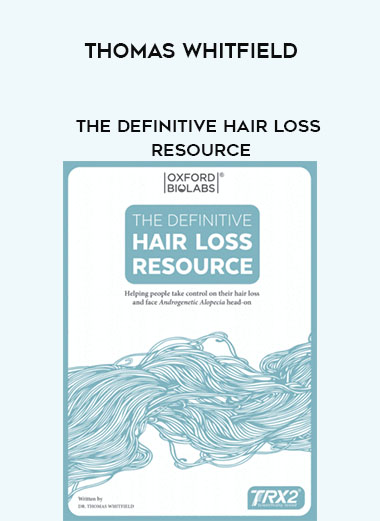
Thomas Whitfield – The Definitive Hair Loss Resource
Table of Contents
1 Introduction
2 Hair Introduction
2.1 Hair Structure and Hair Loss
- 2.1.1 The Anatomical Structure of Hair
- 2.1.2 Why do we have hair?
- 2.1.3 The Cause of Hair Loss
- 2.1.4 Male Reactions to Hair Loss
- 2.1.5 You Are Not Alone
2.2 Hair Care and Hair Products
- 2.2.1 Are you using the right hair care products?
- 2.2.2 Choosing the Right Products
- 2.2.3 Washing and Drying Your Hair
- 2.2.4 How Hair Dyes Work
- 2.2.5 Effects of Gels, Mousses and Dyes on Hair
- 2.2.6 How to Avoid Hair Damage
- 2.2.7 Maintain a Healthy Scalp
3 Why Hair Loss Happens
3.1 Why Men Lose Their Hair
- 3.1.1 Identifying Androgenetic Alopecia (AGA)
3.2 Common Causes of Hair Loss
- 3.2.1 Genes and Family History
- 3.2.2 Testosterone and DHT
- 3.2.3 Hair Loss Over Time
- 3.2.3 Stress
- 3.2.5 Lack of Blood Supply
- 3.2.6 Environmental Issues
3.3 Diseases that Cause Hair Loss
- 3.3.1 Non-Scarring Alopecia
- 3.3.2 Alopecia Areata
- 3.3.3 Diagnosing the Disorder
- 3.3.4 Treatment Options
- 3.3.5 Telogen Effluvium
- 3.3.6 Tinea Capitis
- 3.3.7 Thyroid Conditions and Hair Loss
- 3.3.8 How Thyroid Conditions Affect Our Hair
- 3.3.9 Thyroid Disease Treatments
- 3.3.10 Scarring Alopecia
- 3.3.11 Lupus
3.4 Other Causes of Hair Loss
- 3.4.1 Hair Loss as a Result of Medication
- 3.4.2 Rare Causes of Hair Loss
4 Ways to Conceal Hair Loss
4.1 Wig It
- 4.1.1 A Brief History
- 4.1.2 Hair Replacement Systems
- 4.1.3 Where do I shop for hair systems?
- 4.1.4 Maintenance and Care for Your New Hair
4.2 Fibers, Sprays and Particle Hair Concealers
- 4.2.1 How Hair Concealers Work
- 4.2.2 The Wonders of Hair Fibres
- 4.2.3 Spray-on Hair Concealers
- 4.2.4 Disadvantages of Hair Concealers
- 4.2.5 Research and Compare Before Buying
5 Laser, Topical and Pharmaceutical Treatments
5.1 Prescribed Medications for Hair Loss
- 5.1.1 Level Your Expectations
- 5.1.2 5-alpha-reductase inhibitors
- 5.1.3 How 5-alpha-reductase Inhibitors Work
- 5.1.4 Side-Effects of 5-alpha-reductase Inhibitors
- 5.1.5 Proper Dosing of 5-alpha-reductase Inhibitors
- 5.1.6 Combining 5-alpha-reductase Inhibitors and other OTC medications
- 5.1.7 Low-Level Laser Therapy
- 5.1.8 How Laser Therapy Works
- 5.1.9 Low-Level Laser Therapy for Hair Loss
- 5.1.10 Handheld Laser for Home Use
- 5.1.11 Potential Risks of LLLT
6 Advanced Hair Loss Solutions
6.1 Hair Transplant Surgery
- 6.1.1 Are you a candidate for hair transplant surgery?
- 6.1.2 Those Who Don’t Qualify for a Hair Transplant
- 6.1.3 Those Who May Qualify for a Hair Transplants
- 6.1.4 Having Enough Hair for a Hair Transplant
- 6.1.5 Considering the Costs
- 6.1.6 Choosing the Right Doctor
- 6.1.7 Meeting for the First Consultation
- 6.1.8 The Right Questions to Ask
- 6.1.9 Seeing Results for Yourself
- 6.1.10 Before Surgery
- 6.1.11 During Surgery
- 6.1.12 Possible Complications
- 6.1.13 Hair Care Post-Op
- 6.1.14 Recovering from Anaesthesia
- 6.1.15 Keeping Your Head Crust-Free
- 6.1.16 Hiding Your Head
- 6.1.17 Limiting Your Amount of Physical Activity
6.2 Hair Transplant Complications
- 6.2.1 Post Operative Brow and Facial Swelling
- 6.2.2 Failure of Transplanted Hair to Grow
- 6.2.3 Hair Loss
- 6.2.4 Sun Damage
- 6.2.5 Doing It Again
7 Hair Lifestyle
7.1 Feeding Your Hair Right
- 7.1.1 Essential Protein and Calorie Intake
- 7.1.2 The Good Fat
- 7.1.3 Your Daily Vitamins
7.2 Live Active for a Healthier Head of Hair
- 7.2.1 How Exercise Affects Hair Growth and Hair Loss
- 7.2.2 Make Exercise an Additional Hair Loss Treatment
8 Companies Researching New Treatments
8.1 Research Breakdown
8.2 Oxford BioLabs and TRX2
- 8.2.1 Mission and Goal
- 8.2.2 TRX2
- 8.2.3 The RejuveNation
What is health?
The word health refers to a state of complete emotional and physical well-being. Healthcare exists to help people maintain this optimal state of health.
According to the Centers for Disease Control and Prevention (CDC), healthcare costs in the United States were $3.5 trillionTrusted Source in 2017.
However, despite this expenditure, people in the U.S. have a lower life expectancy than people in other developed countries. This is due to a variety of factors, including access to healthcare and lifestyle choices.
Good health is central to handling stress and living a longer, more active life. In this article, we explain the meaning of good health, the types of health a person needs to consider, and how to preserve good health.
In 1948, the World Health Organization (WHO)Trusted Source defined health with a phrase that modern authorities still apply.
“Health is a state of complete physical, mental, and social well-being and not merely the absence of disease or infirmity.”
In 1986, the WHOTrusted Source made further clarifications:
“A resource for everyday life, not the objective of living. Health is a positive concept emphasizing social and personal resources, as well as physical capacities.”
This means that health is a resource to support an individual’s function in wider society, rather than an end in itself. A healthful lifestyle provides the means to lead a full life with meaning and purpose.
In 2009, researchers publishing inThe LancetTrusted Source defined health as the ability of a body to adapt to new threats and infirmities.
They base this definition on the idea that the past few decades have seen modern science take significant strides in the awareness of diseases by understanding how they work, discovering new ways to slow or stop them, and acknowledging that an absence of pathology may not be possible.
Thomas Whitfield – The Definitive Hair Loss Resource
Readmore About : Thomas Whitfield











![Actioncoach.Kajab - Brad Sugars Profit Masters [Billionaire in Training] download](https://ivseed.info/wp-content/uploads/2022/03/zz.jpg)






















Reviews
There are no reviews yet.